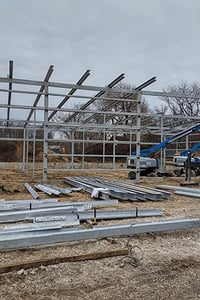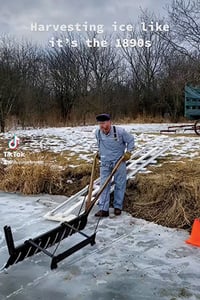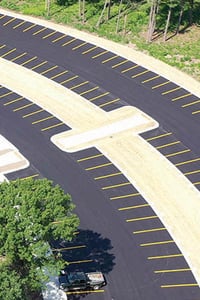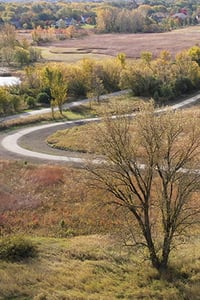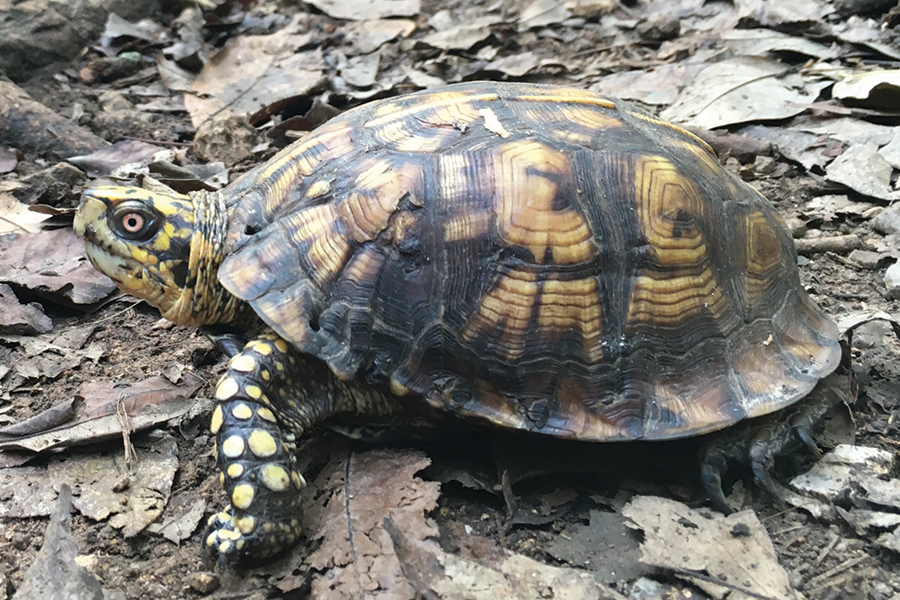Winter Issue 2023
From the President

Happy New Year! I hope this edition finds you and your family well and enjoying all the events and programs offered here at the Forest Preserve District of DuPage County.
In December the District’s Board of Commissioners approved the agency’s budget for 2023, which includes a number of restoration and capital projects with no increase to DuPage property taxes paid to the District.
This year we’re continuing to make significant progress on the implementation of our 2019 master plan, which includes 32 high-priority projects — 11 to restore large natural areas. The most prominent project underway is at Willowbrook Wildlife Center. On-site preparation work has begun, and construction of the new visitor center itself will start next year. Overall, we will be investing over $62 million in our preserves, education centers, trails, roads, restrooms, and bridges.
Exterior renovations at Mayslake Hall will be completed this summer, meaning the interior will again be open, and we have begun to work on the master plan for the entire forest preserve. We’ve also started master planning for Maple Meadows Golf Course with assistance from well-known and respected golf course architect Greg Martin. And golfers, food enthusiasts, and nature lovers alike can now enjoy the new Greenway Tap at The Preserve at Oak Meadows year-round!
In 2023 we’ll also continue to focus on the safety of visitors and our staff and will install cameras at our most popular preserves. We started deploying cameras last year and have already seen a significant drop in theft and other property-related crimes. With over 6 million visitors each year, public safety is a top priority.
We wish you all the best in 2023 and hope to see you on the wintery trails!

Daniel Hebreard
President, Forest Preserve District of DuPage County
News & Notes
Construction Starts on Major Renovation
Phase at Willowbrook Wildlife Center
After a ground-breaking ceremony this summer at Willowbrook Wildlife Center, construction is fully underway on major improvements at the site, which will include a new visitor center.
After setting up on site, the Forest Preserve District contractor continues to prepare the area for concrete foundations for two new structures and concrete pads for additional animal enclosures. A new raptor flight barn will house rehab and resident raptors and include larger areas for short flights and observation. The carnivore enclosure will house the center’s resident bobcat as well as rehabilitating carnivores transitioning to release.
This phase should wrap up in spring, at which time animals on the exhibit trail will move into their new homes. The District’s consultant is hard at work on permits for the remaining phases of work, which will start south of the existing clinic after the resident animals have moved.
Collections Corner
As temperatures drop and the seasons change, artifact displays change, too. For instance, Kline Creek Farm seasonally moves textiles and other pieces from display to storage to protect them from fluctuations in temperature and relative humidity in the 1890s farmhouse, which can dramatically shorten the life of some materials.
Periodic rotation to a climate-controlled storage environment can also safeguard items from dangers such as light, dust, and mold.
These seasonal changes may take some textiles off display this time of year, but they allow Kline Creek Farm to instead interpret other historical artifacts related to winter life on the farm, such as the ice saw and ice hatchet.
Ice saws (pictured here) were used in the 1890s to cut blocks from frozen lakes. Ice hatchets were used to chip odd shapes from the resulting blocks so the blocks would fit tightly together in the icehouse, helping preserve the ice well into summer. Ice saws are common artifacts, but because the ice hatchet is not an easily recognizable tool (and has an odd shape not useful in woodworking), few remain.
This winter, follow the farm on TikTok or Facebook to see Forest Preserve District staff demonstrate ice harvesting and interpret other activities and relics of the past.
Habitat Work Continues at Herrick Lake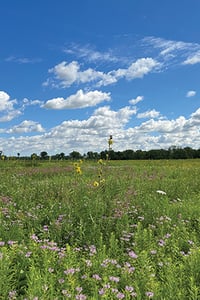
This winter, crews will continue habitat improvement work at the 887-acre Herrick Lake Forest Preserve by removing invasive shrubs and trees throughout oak, prairie, and wetland ecosystems. These efforts will create healthier habitats (including the already-restored prairie below) for the 545 native plant and 238 native wildlife species that live at the preserve — some state-endangered, state-threatened, or rare. When completed, the project will create a mosaic of 550 acres of restored habitat, one of the largest such areas in the county.
Trail fans should note, though, that the work will require closing a section of the Green Heron Trail and the spur leading to Herrick Road through mid-March. The Forest Preserve District will post signs to let visitors know where these stretches begin and end.
Work Begins at Fischer Woods
The Forest Preserve District will begin to revitalize oak habitats this winter at Fischer Woods Forest Preserve. The main goal will be to remove invasive shrubs and trees, such as European buckthorn and honeysuckle, which produce dense clumps of leaves. This impenetrable vegetation keeps sun and water from reaching the wildflowers and oak and hickory seedlings that grow below. As a result, the variety of plants and animals that live at Fischer Woods has been declining. Similar work throughout the Forest Preserve District has shown that not only plants but also populations of birds and butterflies can recover once the weedy vegetation is removed. This winter, crews will cut and mow invasive trees and shrubs and will carefully apply herbicides to the cut stumps so the plants can’t grow back. They may also chip trees and brush and create and burn brush piles.
Because equipment is large and will be moving at a fast pace, visitors may periodically see “area closed” signs. The Forest Preserve District expects work to wrap up by December 2025.
Expanded Parking at Waterfall Glen
Forest Preserve District visitors can now enjoy expanded access to the trails at Waterfall Glen thanks to a new 180-car parking lot off Bluff Road.
The lot, a 2019 certified master plan project, reduces pedestrian conflicts near the intersection of Cass Avenue and Bluff Road and improves access to the trails. The former 17-car lot could not adequately accommodate the increasing number of visitors to the Rocky Glen area, one of the more popular destinations at the preserve, and frequently resulted in overflow parking on Bluff Road and Cass Avenue. The project not only expanded spots by more than 10 fold but also rerouted the trail and installed a new trailhead. A future 0.3-acre picnic area will further enhance the site.
The new lot was open by Labor Day weekend, weeks ahead of its target completion date.
The project’s design was coordinated with an ongoing habitat restoration project at the preserve to lessen effects to natural resources, minimize disruption, and enhance the overall visitor experience.
Grant to Benefit Blackwell Forest Preserve
The Forest Preserve District of DuPage County and the DuPage Birding Club jointly announced that the club awarded a $2,000 grant to the 501(c)(3) Friends of the Forest Preserve District of DuPage County to fund the planting of nearly 100 native tree saplings and shrubs near McKee Marsh at Blackwell Forest Preserve in Warrenville.
The grant will advance a restoration project already begun at the site, which included the removal of nonnative buckthorn and honeysuckle shrubs. Newly planted native trees and shrubs will increase the habitat’s biodiversity, provide needed vegetative structure, and restore resources for native and migratory birds that nest and forage in the woodland’s understory.
The Forest Preserve District expects it will take several years for the saplings and shrubs to reach maturity before the habitat provides the conditions required by understory-nesting birds.
2023 Annual Permits
Purchase 2023 annual permits for off-leash dog areas, archery, private watercraft, and model boats and aircraft online 24/7 at dupageforest.org. Just go to our Permits page, scroll to the one you want, click “Add to Cart,” and follow the instructions. You’ll receive your permit via U.S. mail.
Interested in picnic or family camping sites? You can make reservations 24/7 from our Reservations page up to a year in advance. For details call Visitor Services at 630-933-7248 Monday – Friday 8 a.m. – 4 p.m.
Live and on Demand
Can’t make it to a board meeting? Find schedules and agendas and watch it live or on demand under “Our Board.” You can also link directly to live streaming video from the Forest Preserve District’s Facebook page at facebook.com/dupageforest.
Commission meetings and planning sessions are open to the public and held at Forest Preserve District headquarters at 3S580 Naperville Road in Wheaton. Normally, commission meetings are at 8 a.m. on the first and third Tuesdays of the month; planning sessions, 8 a.m. on the second and fourth Tuesdays. At both the board hears public comments and staff reports, discusses business, and votes on agenda items.
District Celebrates Important Trail Connection
In October, the Forest Preserve District celebrated the opening of a new 1.7-mile section of limestone trail in Pratt’s Wayne Woods, an important connection between the forest preserve’s trails and the Elgin Branch of the Illinois Prairie Path.
The new trail segment marks the completion of the nearly 20-mile North Central DuPage Regional Trail, which spans northern DuPage County and connects the Elgin Branch of the Illinois Prairie Path on the west to Cook County’s Busse Woods in Elk Grove Village on the east. It includes side paths as well as on-road and off-street trails.
The final segment runs along the west side of Munger Road starting at Forest Preserve Drive, crosses Army Trail Road, and ends at Smith Road, where it connects to the Illinois Prairie Path.
The Forest Preserve District received $1.5 million in Surface Transportation Program funds and $152,000 from the federally funded locally programmed Transportation Alternatives Program for the construction of this final segment.
Many Thanks
Friends of the Forest Preserve District of DuPage County 501(c)(3) advances the vision of the Forest Preserve District through philanthropic endeavors, helping to maintain and sustain nearly 26,000 acres at 60 forest preserves; care for 166 miles of trails; and operate six centers. We are pleased to acknowledge the generosity of individuals, corporations, and foundations for their gifts from June through September, which supported habitat restoration in the preserves, wildlife conservation, educational and recreational programs, green-energy initiatives, and master plan projects.
As we begin the new year, consider becoming part of our Ambassadors Circle or Community Partners programs. Learn more at dupageforest.org/friends or contact our partnership and philanthropy team at fundraising@dupageforest.org or 630-871-6400. You can also mail a check payable to the Friends of the Forest Preserve District of DuPage County at 3S580 Naperville Road in Wheaton, 60189.
Estate of Pamela Hoehl
$15,362 — Willowbrook Wildlife Center
Kline Creek Farm Visitors
$7,006 — Kline Creek Farm
Jeffrey Jens
$5,000 — Willowbrook Wildlife Center
Willowbrook Wildlife Center Visitors
$4,845 — Willowbrook Wildlife Center
Estate of Lila Heichel
$3,000 — Willowbrook Wildlife Center
ComEd, an Exelon Company
$2,500 — Community partner
V3 Companies
$2,500 — Community partner
Friends of the Glen Ellyn Public Library
$1,000 — Education
Galusha Farms
$1,000 — A Night for Nature sponsor
Girl Scout Troop 55557
$1,000 — Willowbrook Wildlife Center
Glen Ellyn Library Foundation
$1,000 — Education
Marilyn Schweitzer and Michael Firman
$1,000 — Education, natural resources, and Willowbrook Wildlife Center
Michael Kerr
$1,000 — Greatest needs
Red Oak Disposal Services
$1,000 — A Night for Nature sponsor
Stantec Consulting Services Inc.
$1,000 — A Night for Nature sponsor
The Richard Laurence Parish Foundation
$1,000 — Greatest needs
Wight & Company
$1,000 — A Night for Nature sponsor
Adtalem Global Education
$500 — Natural resources
Frances Holbrook
$500 — Greatest needs
Girl Scout Troop 56172
$500 — Blanding’s turtle head-start program
H. Susan Jones Charitable Fund of DuPage Foundation
$500 — Greatest needs
Johathan Helmus
$500 — Greatest needs
Keith Tomes
$500 — Willowbrook Wildlife Center
Steve and Megan Shebik
$500 — Danada Equestrian Center
The Conservation Foundation
$500 — A Night for Nature sponsor
Wheaton Lions Club
$500 — A Night for Nature duck race sponsor
6,000 Years in the Making
A fresh blanket of powdery snow glistens in the morning sunlight. With these conditions, who can resist the urge to blaze a trail, making the first tracks across the winter wonderland? With some preparation and practice, a pair of snowshoes can help you get outside this time of year, giving you a way to stay active and soak in sunlight and fresh air.
Snowshoeing has gained popularity as a recreational activity over the past few decades. With minimal gear, expenses, or expertise, you can strap snowshoes onto winter boots and start exploring. Snowshoeing is an easy-to-learn, low-impact, strength-building activity suitable for all ages that lets you “float” across deep snow instead of sinking in. Today’s snowshoes are often used for recreation, but early snowshoes were designed exclusively out of necessity for winter survival.
Archaeological evidence and written records are scarce, but the consensus is that snowshoes originated in central Asia at least 6,000 years ago. Perhaps people noticed how animals with large feet such as lynx, snow leopards, and hares expertly navigated through deep snow. By distributing one’s weight across a larger surface area, an animal or human uses less energy to move and doesn’t sink into the snow as much.
The first snowshoes were more like “shoe-skis,” each a large patch of leather with a block of wood attached to the foot. As people migrated from central Asia and adapted to living in other parts of the world these “shoe-skis” adapted, too. In northern Europe, the wooden blocks became longer and longer, developing into today’s cross-country skis.
For people who migrated across the Bering Sea land bridge into North America, “shoe-skis” became wider, eventually evolving into today’s snowshoes.
Most early snowshoes were made of large thin branches — typically ash, spruce, birch, elm, or hickory — and woven animal sinew or the hides of caribou, moose, or deer. (Four early designs are featured in the photos accompanying this article). Between the 1950s and 70s new materials changed the snowshoe, although the goal of flotation remained the same. Modern frames are aluminum, plastic, or foam, making shoes more lightweight and maneuverable, with rubber or plastic straps and bindings, making them easier to tighten with less maintenance than leather and laces. As an added feature, metal cleats improve traction on slippery or hilly surfaces.
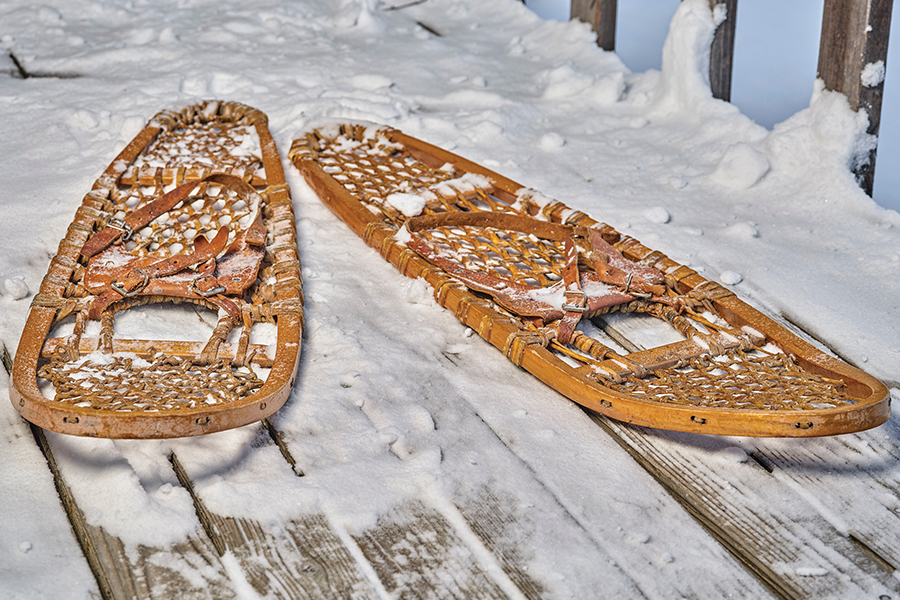
The bear paw is short and wide and has intricate, tightly woven lacing. Its strong, lightweight design provides more surface area to float better in the dry, powdery snow and hilly terrain of the far north. The tailless, oval shape loses speed but gains maneuverability through thicker underbrush. Image marekuliasz/Shutterstock.com
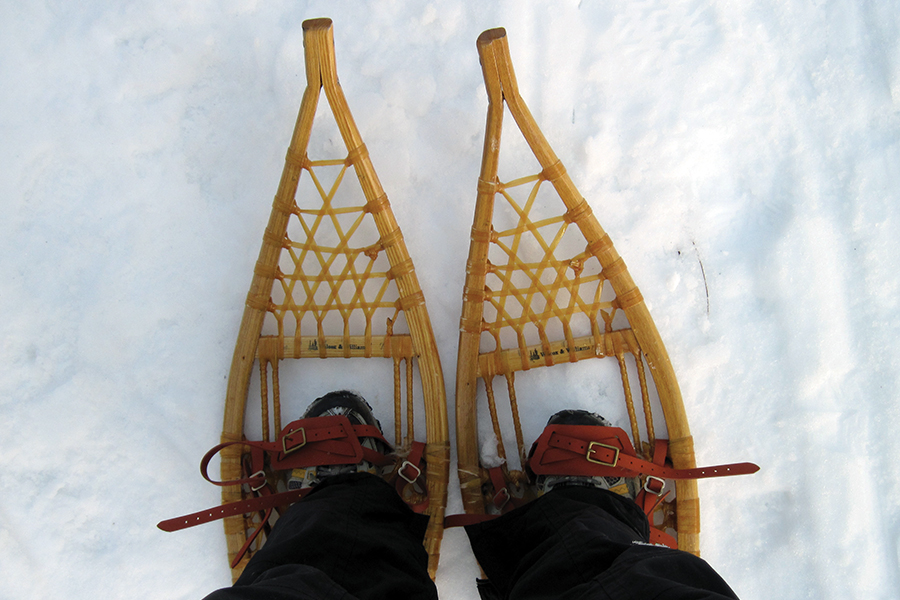
Originating among woodland tribes of central Canada and the Midwest, the Ojibwa shape has an upturned nose with pointed tails. This long narrow shape was designed to carry heavy loads across flat open land and to increase agility and speed for hunting. Some of the earliest designs were over 7 feet long! Image by Alexi Ueltzen/CC BY-NC 2.0
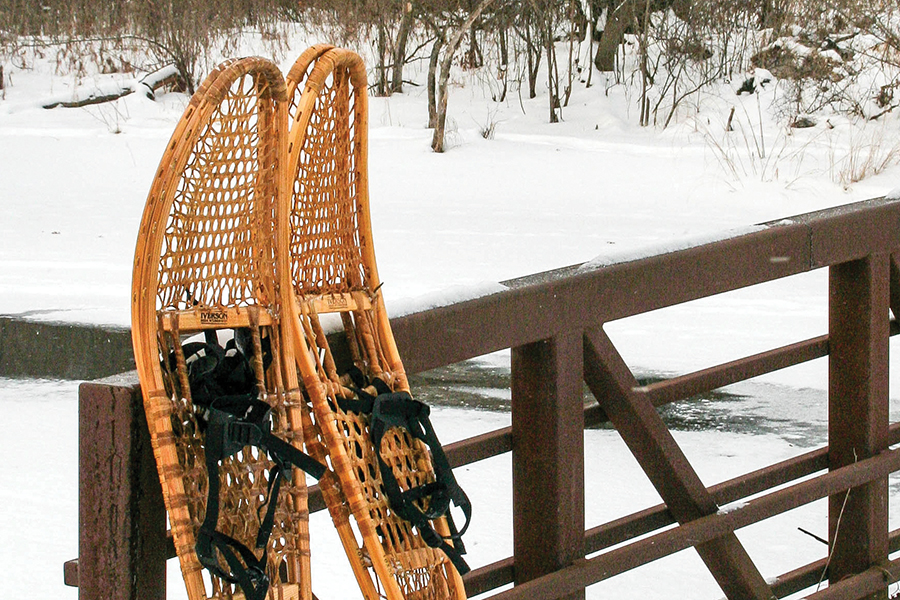
The Athabaskan, or Alaskan, style originated in Alaska and along the Canadian west coast. The lacing has a looser weave to move through heavy, wet snow and slush. Its shape is similar to the Ojibwa, but it is usually longer for carrying heavy loads and keeping up with sleds. Image Denise Gerdes/Shutterstock.com
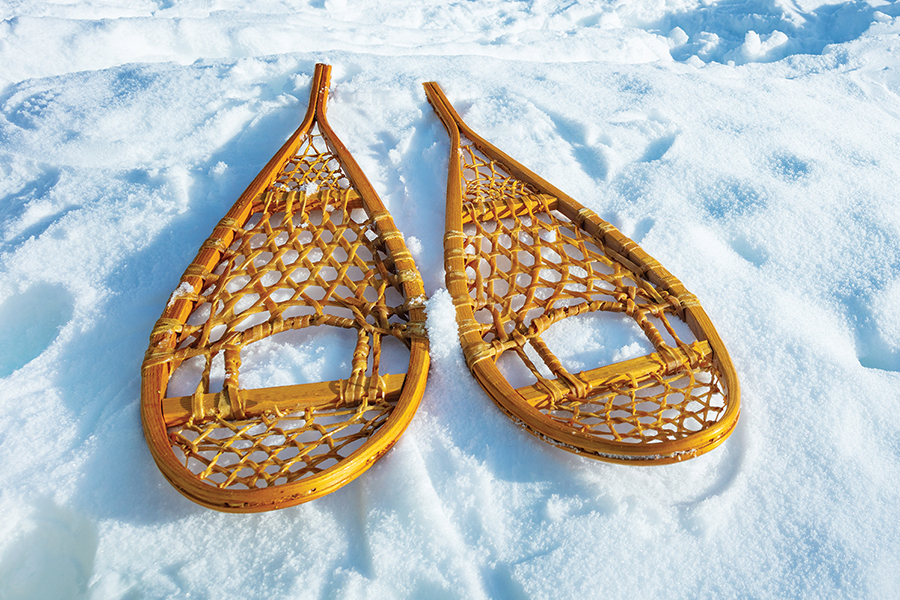
The recognizable racquet shape of the Huron, or beaver tail, snowshoe has a rounded, upturned nose and comes together in the back with a narrow stabilizing tail to navigate through deep, powdery snow across open, flat land. Image Sergey Novikov/Shutterstock.com
Getting to the Bottom of Brumation
The groundhog might get all the press for its ability to spend winter hibernating in its den, but it’s not the only example of DuPage wildlife that slow things down this time of year.
Animals have a lot of strategies for dealing with winter. In fall, when temperatures and sunlight send clear signals that it’s time to prepare for colder weather, some animals fatten up to ready for the leaner times ahead. Others fly south to avoid conditions altogether. A handful of mammals, the groundhog included, hibernate, spending extended periods of inactivity underground, where heart rates, breathing, and body temperatures drop. The county’s cold-blooded animals have a similar strategy, although one scientists give a different name.
“Brumation” is the prolonged period of decreased metabolic rate amphibians and reptiles undergo to cope with winter, but the specifics can vary by species.
Frogs with their thin skins are susceptible to environmental pollutants and can seem rather frail, but they can be tough in other ways. To cope with the onset of winter, for instance, some frogs settle on the bottom of wetlands or lakes with oxygen-rich waters. Others stay on land and either burrow in the soil or work their way under rocks or logs.
Some wood frogs in particular have a simple yet amazing technique: They bury themselves under the leaf litter and freeze.
As a wood frog cools, to conserve moisture, it no longer passes urine. Instead, the urea is added to the animal’s blood, where along with glucose from sugars in the liver it acts as a sort of antifreeze that the heart circulates throughout the body. This doesn’t stop the freezing process, but it does protect cells as they freeze by retaining critical moisture. As temperatures drop, more of the frog will freeze, and when most of the frog is frozen, the heart and lungs eventually stop. As spring approaches, though, the wood frog begins to thaw and the heart to pump, returning all organs to their normal functions.
It’s not surprising that medical doctors are studying the wood frog. An understanding of how its body can function with exceptionally high glucose levels may lead to breakthroughs in diabetes care. Learning how cells and organs can survive prolonged periods of low oxygen may lead to improved recoveries for stroke and heart attack patients as well as better care for organs used in transplants.
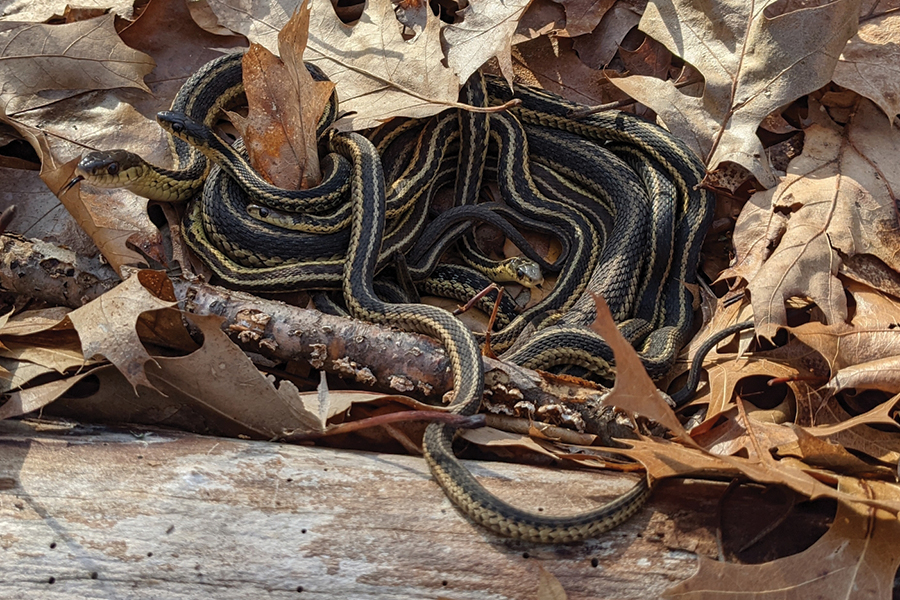
Snakes, such as these eastern garter snakes, spend winter in groups in protected areas call hibernacula. Image by LilyM/CC BY-NC 4.0
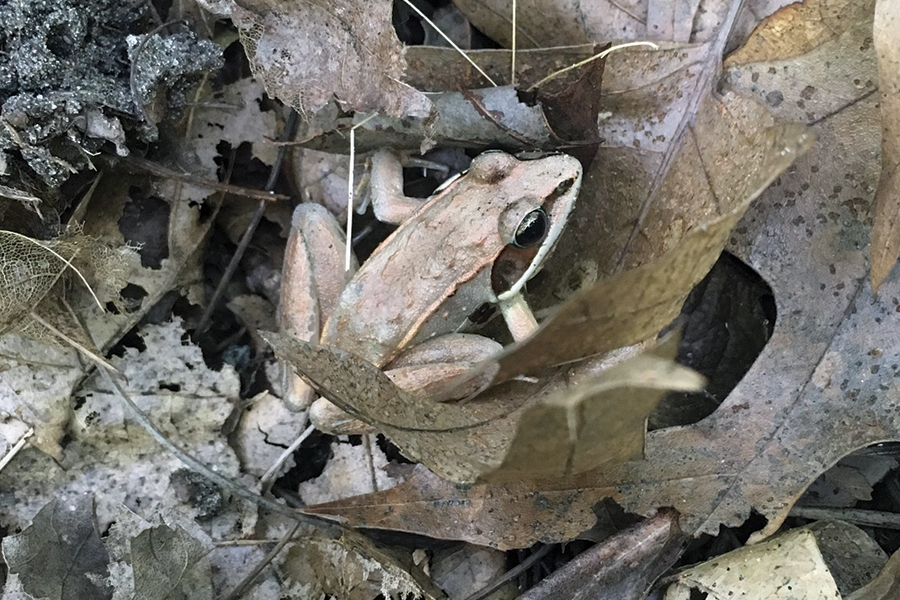
Scientists study wood frogs for their ability to spend winter frozen below the leaves without any tissue damage. Image by mcaple/CC BY-NC 4.0
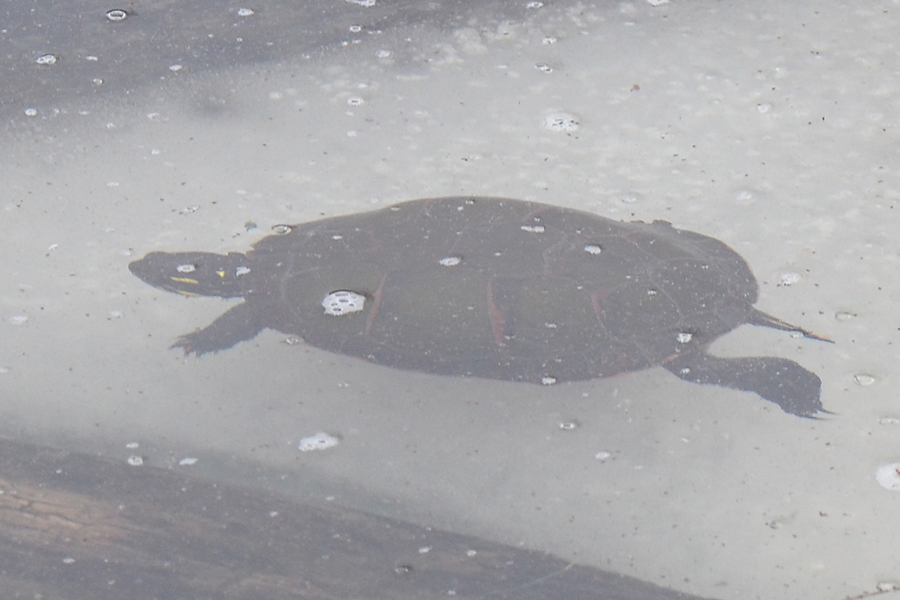
Brumating aquatic turtles take in oxygen through cloaca bursa near their tails. Image by J. D. Sommer/CC BY-NC 4.0
Turtles have similar brumation strategies. In summer a turtle’s heart may beat 40 times a minute, but during the coldest part of winter, it may only beat one time every 10! Still, even with such a dramatically reduced metabolic rate, a turtle needs to take in oxygen and to remove carbon dioxide that builds up in the blood. For terrestrial species, such as box turtles, which burrow into the soil below the frost line, this isn’t an issue; but for aquatic turtles, such as painted turtles, that settle into the muck at the bottom of ponds or marshes, it takes some special breathing adaptations.
Since aquatic turtles are under the ice, they can’t breathe in the normal way by using their lungs. They instead breathe through a process called cloacal respiration.
Multipurpose sacs collectively called the cloaca bursa are situated under the turtle’s tail. They’re used for waste removal and reproduction, but their numerous blood vessels also allow them to absorb high concentrations of oxygen and to release carbon dioxide. (In a way, this lets some turtles to breathe through their butts!) Some frogs and salamanders are capable of similar respiration.
For snakes, there’s a group approach when it comes to brumation. Many species congregate in “hibernacula,” chambers (usually underground and below the frost line) that protect snakes from the cold and allow the animals to better moderate the lower temperature while maintaining oxygen and humidity levels with relatively no disturbance. Hibernacula can be in abandoned mammal dens, cracks in the bedrock, or structures such as rock walls, building foundations, or railroad beds. Snakes with less tolerance to cold are the first to enter the hibernaculum to brumate; those with more tolerance will be the last ones in and the first ones out in spring.
It’s fascinating to learn and understand the complex abilities animals have to withstand the challenges winter presents. Next spring when you hear the first frogs calling, you’ll now understand just a little of what they went through to survive winter’s harsh conditions.
